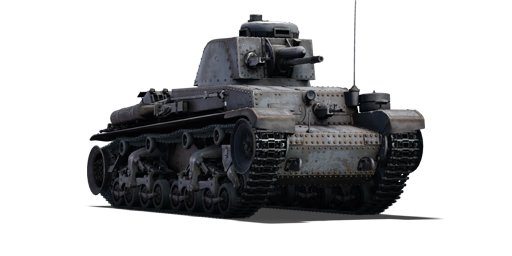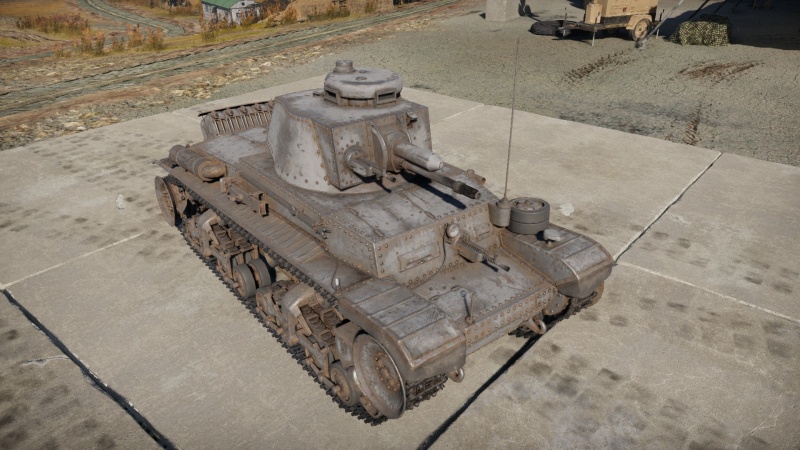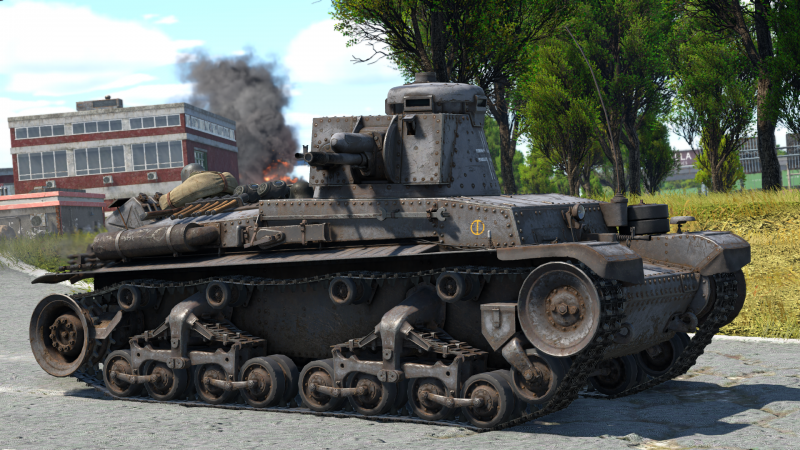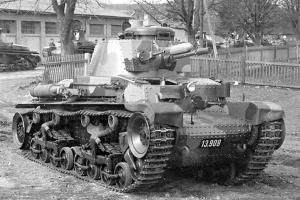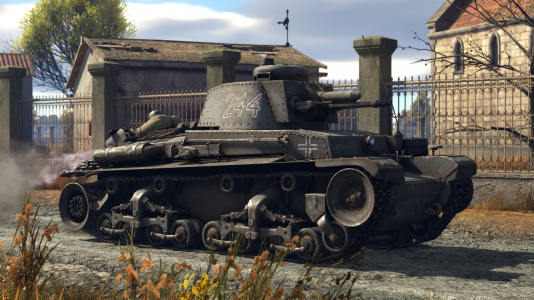Difference between revisions of "Pz.35(t)"
(→Description) |
|||
| (53 intermediate revisions by 17 users not shown) | |||
| Line 1: | Line 1: | ||
| − | {{Specs-Card|code=germ_pzkpfw_35t}} | + | {{Specs-Card |
| + | |code=germ_pzkpfw_35t | ||
| + | |images={{Specs-Card-Image|GarageImage_{{PAGENAME}}.jpg|ArtImage2_{{PAGENAME}}.png}} | ||
| + | }} | ||
== Description == | == Description == | ||
| − | ''In the description, the first part | + | <!-- ''In the description, the first part should be about the history of the creation and combat usage of the vehicle, as well as its key features. In the second part, tell the reader about the ground vehicle in the game. Insert a screenshot of the vehicle, so that if the novice player does not remember the vehicle by name, he will immediately understand what kind of vehicle the article is talking about.'' --> |
| + | The '''Panzerkampfwagen 35(t)''', also known as ''LT vz.35'', was a Czechoslovakian light tank designed in 1935 by engineers at Škoda. The LT vz.35 was the most numerous tank in the Czechoslovakian army; during its serial production until 1939, 434 units were manufactured. After the German occupation of Czechoslovakia in 1939, these tanks were taken into service by the Wehrmacht, where they received the designation Pz.35(t) (''Tschecherei'': "Czech"). They formed the core of the German 1st Light Division and, after its reorganisation, the 6th Tank Division. The tanks were actively used by the Wehrmacht during the invasion of Poland, France, and the USSR in 1939-41. In smaller numbers, they were also used by the armies of Romania, Slovakia, Bulgaria, and Hungary, to which they were exported from Germany. | ||
| + | |||
| + | Introduced in [[Update 1.51 "Cold Steel"]], the Pz.35(t) represents an average but versatile vehicle, which copes well with a wide range of tasks on the battlefield. On the other hand, it does not excel in anything: in mobility, the Pz.35(t) is inferior to many other light tanks, and its armour and survivability are generally mediocre. However, the decent 37 mm gun and good frontal armour allow the vehicle to successfully perform the role of a "second line" machine. | ||
== General info == | == General info == | ||
=== Survivability and armour === | === Survivability and armour === | ||
| − | ''Describe armour protection. Note the most well protected and key weak areas. Appreciate the layout of modules as well as the number and location of crew members. Is the level of armour protection sufficient, is the placement of modules | + | {{Specs-Tank-Armour}} |
| + | <!-- ''Describe armour protection. Note the most well protected and key weak areas. Appreciate the layout of modules as well as the number and location of crew members. Is the level of armour protection sufficient, is the placement of modules helpful for survival in combat? If necessary use a visual template to indicate the most secure and weak zones of the armour.'' --> | ||
| − | '' | + | '''Armour type:''' |
| + | |||
| + | * Rolled homogeneous armour | ||
| + | * Cast homogeneous armour (Cupola) | ||
| + | |||
| + | {| class="wikitable" | ||
| + | |- | ||
| + | ! Armour !! Front (Slope angle) !! Sides !! Rear !! Roof | ||
| + | |- | ||
| + | |Hull || |25 mm (18°) ''Front plate'' <br> 16 mm (80°) ''Front glacis'' <br> 25 mm (31°) ''Lower glacis'' || 16 mm || 16 mm || 12 mm | ||
| + | |- | ||
| + | |Turret || 25 mm (10°)''Turret front'' <br> 25 mm ''Gun mantlet'' || 16 mm || 16 mm || 8 mm | ||
| + | |- | ||
| + | |Cupola || colspan="3" style="text-align:center" | 25 mm (cylindrical) || 25 mm (4°) | ||
| + | |- | ||
| + | |} | ||
| + | |||
| + | '''Notes:''' | ||
| + | |||
| + | * Suspension wheels and tracks are 15 mm thick while and torsion bars are 8 mm thick. | ||
| + | * The belly is 8 mm thick. | ||
| + | * Mudguards and fuel cans are 4 mm thick. | ||
| + | |||
| + | The {{PAGENAME}} has a key advantage over most low battle rated tanks which is found also on French tanks - it has 25 mm front armour on the hull and turret which makes it immune to 12.7 mm machine guns that are commonplace at its tier, however, the sides can be penetrated with such weapons. It has four crew with decent spacing between them, but a far cry from the Panzer III/IV, so while it can save you sometimes, don't rely on it, especially if a Soviet APBC or British 2-pdr shell is coming your way. | ||
=== Mobility === | === Mobility === | ||
| − | ''Write about the mobility of the ground vehicle. Estimate the specific power and | + | {{Specs-Tank-Mobility}} |
| + | <!-- ''Write about the mobility of the ground vehicle. Estimate the specific power and manoeuvrability, as well as the maximum speed forwards and backwards.'' --> | ||
| + | |||
| + | {{tankMobility|abMinHp=186|rbMinHp=106}} | ||
| + | |||
| + | With a top speed of 33 km/h and a power-to-weight ratio of 11.43 hp/ton in Realistic and Simulator battles, the {{PAGENAME}} has reasonably good mobility for a reserve tank. With a top speed almost 20 km/h faster than yours, Stuart and BT tanks are notable enemies as they will flank you quickly. | ||
| + | |||
| + | === Modifications and economy === | ||
| + | {{Specs-Economy}} | ||
== Armaments == | == Armaments == | ||
| + | {{Specs-Tank-Armaments}} | ||
=== Main armament === | === Main armament === | ||
| − | ''Give the reader information about the characteristics of the main gun. Assess its effectiveness in a battle based on the reloading speed, ballistics and the power of shells. Do not forget about the | + | {{Specs-Tank-Weapon|1}} |
| + | <!-- ''Give the reader information about the characteristics of the main gun. Assess its effectiveness in a battle based on the reloading speed, ballistics and the power of shells. Do not forget about the flexibility of the fire, that is how quickly the cannon can be aimed at the target, open fire on it and aim at another enemy. Add a link to the main article on the gun: <code><nowiki>{{main|Name of the weapon}}</nowiki></code>. Describe in general terms the ammunition available for the main gun. Give advice on how to use them and how to fill the ammunition storage.'' --> | ||
| + | {{main|KwK34(t) (37 mm)}} | ||
| + | |||
| + | {| class="wikitable" style="text-align:center" width="100%" | ||
| + | |- | ||
| + | ! colspan="5" | [[KwK34(t) (37 mm)|37 mm KwK34(t)]] || colspan="5" | Turret rotation speed (°/s) || colspan="4" | Reloading rate (seconds) | ||
| + | |- | ||
| + | ! Mode !! Capacity !! Vertical !! Horizontal !! Stabilizer | ||
| + | ! Stock !! Upgraded !! Full !! Expert !! Aced | ||
| + | ! Stock !! Full !! Expert !! Aced | ||
| + | |- | ||
| + | ! ''Arcade'' | ||
| + | | rowspan="2" | 72 || rowspan="2" | -10°/+25° || rowspan="2" | ±180° || rowspan="2" | Vertical || 13.3 || 18.5 || 22.4 || 24.8 || 26.4 || rowspan="2" | 4.29 || rowspan="2" | 3.80 || rowspan="2" | 3.50 || rowspan="2" | 3.30 | ||
| + | |- | ||
| + | ! ''Realistic'' | ||
| + | | 8.3 || 9.8 || 11.9 || 13.2 || 14.0 | ||
| + | |- | ||
| + | |} | ||
| + | The {{PAGENAME}} is armed with the 37 mm KwK 34(t), which has an APC shell with 55 mm pen and a Tier I unlockable APC shell with 53 mm pen, which is essentially worse in every aspect. It also possesses an 85 mm penetration APCR shell for more heavily armoured targets such as [[B1 bis]]. | ||
| − | === | + | ==== Ammunition ==== |
| − | '' | + | {{:KwK34(t) (37 mm)/Ammunition|Pzgr. 34(t), PzGr. 40, Pzgr.(t) umg.}} |
| + | |||
| + | '''Note:''' The PzGr. 34(t) round has no tracer. | ||
| + | |||
| + | ==== [[Ammo racks]] ==== | ||
| + | [[File:Ammoracks_{{PAGENAME}}.png|right|thumb|x250px|[[Ammo racks]] of the {{PAGENAME}}]] | ||
| + | {| class="wikitable" style="text-align:center" | ||
| + | |- | ||
| + | ! Full<br>ammo | ||
| + | ! 1st<br>rack empty | ||
| + | ! 2nd<br>rack empty | ||
| + | ! Visual<br>discrepancy | ||
| + | |- | ||
| + | | '''72''' || 37 ''(+35)'' || 1 ''(+71)'' || No | ||
| + | |- | ||
| + | |} | ||
| + | Notes: | ||
| + | |||
| + | * Racks disappear after you've fired all shells in the rack. | ||
| + | * To go into battle with the right flank empty of ammo, pack 37 ''(+35)'' shells (rack 1 emptied). | ||
=== Machine guns === | === Machine guns === | ||
| − | ''Offensive and anti-aircraft machine guns not only allow you to fight some aircraft | + | {{Specs-Tank-Weapon|2}} |
| + | <!-- ''Offensive and anti-aircraft machine guns not only allow you to fight some aircraft but also are effective against lightly armoured vehicles. Evaluate machine guns and give recommendations on its use.'' --> | ||
| + | {{main|MG37(t) (7.92 mm)}} | ||
| − | == Usage in | + | {| class="wikitable" style="text-align:center" width="50%" |
| − | ''Describe the tactics of playing in the vehicle, the features of using vehicles in the team and advice on tactics. Refrain from creating a "guide" - do not impose a single point of view but give the reader food for thought. Describe the most dangerous enemies and give recommendations on fighting them. If necessary, note the specifics of the game in different modes (AB, RB, SB).'' | + | |- |
| + | ! colspan="5" | [[MG37(t) (7.92 mm)|7.92 mm MG37(t)]] | ||
| + | |- | ||
| + | ! Mount !! Capacity (Belt) !! Fire rate !! Vertical !! Horizontal | ||
| + | |- | ||
| + | | Coaxial || 1,800 (200) || 768 || N/A || N/A | ||
| + | |- | ||
| + | |} | ||
| + | |||
| + | The small calibre of the MG37(t) machine gun makes it largely ineffective against all armoured vehicles but the ones with an open compartment. It still can be used to ping targets as a rangefinding help or to mow down minor obstacles blocking your line of sight. | ||
| + | |||
| + | == Usage in battles == | ||
| + | <!-- ''Describe the tactics of playing in the vehicle, the features of using vehicles in the team and advice on tactics. Refrain from creating a "guide" - do not impose a single point of view but instead give the reader food for thought. Describe the most dangerous enemies and give recommendations on fighting them. If necessary, note the specifics of the game in different modes (AB, RB, SB).'' --> | ||
| + | |||
| + | The tank is average in most aspects, aside from frontal immunity to .50 cals. Since your common enemies (eg. [[BT-5]]s) are faster than you, it is advisable to use this tank as a mid-range support vehicle. At the start of the match, avoid getting surrounded by enemies by not rushing to the frontline straight away, because its hull and turret traverse are all quite bad, making it vulnerable to surprise flanks. Find hilly terrain and utilise your 10 degrees gun depression to poke out, get a shot, then get back into cover before the enemies notice you. | ||
| + | |||
| + | At the middle stages of the match, only go to the frontline when you really need to, because, again, the traverse speed is low and the manoeuvrability isn't great. However the player can now use the tank's small profile to ambush enemies near a friendly point. With their decent penetration up close and the 22 g TNT, the APC rounds can quickly finish off anyone trying to de-cap the point. | ||
| + | |||
| + | Note that the default shell Pzgr. 34(t) has no tracer component, and the player can use this to their advantage. If the player misses the shot, the enemy will not see the trajectory of the shell thus will take longer to locate the shooter. | ||
| + | |||
| + | '''Enemies worth noting:''' | ||
| + | |||
| + | * [[BT-5]], [[BT-7]], [[M2]], [[M3 Stuart (Family)|M3 Stuarts]]: If those tanks survive the first few minutes of point-capping, then they can silently appear pretty much anywhere on the map, including your side. To avoid being flanked / circled, do not put yourself at the frontline, as previously suggested. If you see / hear one of them sneaking up around you, turn your hull and turret together to double the traverse speed so it's quicker to get the guns on them. | ||
| + | |||
| + | * [[B1 bis]]: If it is not possible to avoid fighting this tank, then the best solution is to try and flank it. Hitting the side armour and knocking out its crew is the best way. In a face to face combat, load the APCR and aim for the near-vertical driver's compartment. The B1's driver and commander (also the gunner for the turret) are lined up so a penetration is likely to kill both of them, disabling its mobility and turret for 10 seconds or so. Also don't forget to avoid the hull-mounted 75 mm gun. | ||
=== Pros and cons === | === Pros and cons === | ||
| − | '' | + | <!-- ''Summarise and briefly evaluate the vehicle in terms of its characteristics and combat effectiveness. Mark its pros and cons in a bulleted list. Try not to use more than 6 points for each of the characteristics. Avoid using categorical definitions such as "bad", "good" and the like - use substitutions with softer forms such as "inadequate" and "effective".'' --> |
'''Pros:''' | '''Pros:''' | ||
| − | * | + | |
| + | * Gun depression of -10° is great for combating across any terrain | ||
| + | * Stock and unlockable ammo with explosive filler have decent penetration and good post-penetration damage | ||
| + | * Mobility and acceleration are decent for the tier | ||
| + | * Frontally immune to 12.7 mm machine guns, useful against foes like [[M13 MGMC]] | ||
| + | * Reverse speed of -34 km/h is excellent at pulling the tank out of danger | ||
| + | * Has a shoulder stabiliser, useful for close-quarters combat and shoot-n-scoot | ||
'''Cons:''' | '''Cons:''' | ||
| − | * | + | |
| + | * Many other tanks are faster than it, like [[BT-5]], [[A13 (Family)|A13]], [[M3 Stuart (Family)|M3]] | ||
| + | * Gun is inadequate against higher tier tanks like [[T-70]], [[T-28 (Family)|T-28]] | ||
| + | * Poor survivability and armour against anything stronger than machine guns | ||
| + | * Low agility: sluggish hull traverse and slow turret rotation | ||
== History == | == History == | ||
| − | ''Describe the history of the creation and combat usage of the | + | <!-- ''Describe the history of the creation and combat usage of the vehicle in more detail than in the introduction. If the historical reference turns out to be too long, take it to a separate article, taking a link to the article about the vehicle and adding a block "/History" (example: <nowiki>https://wiki.warthunder.com/(Vehicle-name)/History</nowiki>) and add a link to it here using the <code>main</code> template. Be sure to reference text and sources by using <code><nowiki><ref></ref></nowiki></code>, as well as adding them at the end of the article with <code><nowiki><references /></nowiki></code>. This section may also include the vehicle's dev blog entry (if applicable) and the in-game encyclopedia description (under <code><nowiki>=== In-game description ===</nowiki></code>, also if applicable).'' --> |
| + | [[File:LT vz. 35 (1939).jpg|right|thumb|Czechoslovak LT vz. 35 ready for transfer to Panzertruppe in March 1939. The fate of this particular tank is unknown.]] | ||
| + | |||
| + | The Czechoslovakian main battle tank prior to German occupation, 398 were built between 1936 and 1939. They called it the Light Tank vz (model) 35. Another 126 were exported to Romania in 1936, where they were called the R-2. The Germans seized 244 of the 35(t) models when they invaded in 1939, with another 52 kept by Slovakia. The 6th Panzer Brigade used the 35(t) in the invasion of Poland. The 6th Panzer Division used it used it most notably in the Battle of France and in the invasion of Russia. It was retired from German service in 1942 but remained in service until the end of the war in countries like Romania. | ||
| + | |||
| + | {{break}} | ||
| + | {{Navigation-Start|{{Annotation|Archive of the in-game description|An archive of the historical description of the vehicle that was presented in-game prior to Update 1.55 'Royal Armour'}}}} | ||
| + | {{Navigation-First-Simple-Line}} | ||
| + | The Škoda LT vz.35 light tank was developed between 1935 and 1936. This tank was put into service in 1936, and by 1937 it had become the primary tank of the Czechoslovakian army. Between 1935 and 1940, 424 LT vz.35 tanks were produced. 218 tanks of this model were accepted into service in Wehrmacht and used until 1942. The tank was inferior to the Pz.38(t) in many ways, and its crews were not sorry to see it go. | ||
| + | |||
| + | The tank was equipped with a pneumatic servomotor that made it easier to control the transmission and brakes. However, in winter condition on the Eastern Front it would freeze, and the tank would have to be warmed up. While in Wehrmacht service the tank's crew was also increased to four from the original three. The crew included a commander, a gunner, and a loader, who combined the duties of a radio operator and a mechanic/driver. The tank's power train was redesigned and made highly reliable. For example, the tracks could go for 8,000 km (almost 5,000 miles) before wearing out. | ||
| + | |||
| + | These tanks were used in combat operations in Poland, France, and the USSR. But while the Pz. 35(t) was effective in Poland and France, in the USSR it was, more often than not, helpless. | ||
| + | {{Navigation-End}} | ||
== Media == | == Media == | ||
| − | '' | + | <!-- ''Excellent additions to the article would be video guides, screenshots from the game, and photos.'' --> |
| − | == | + | ;Images |
| − | ''Links to the articles on the War Thunder Wiki that you think will be useful for the reader, for example | + | <gallery mode="packed-hover" heights="200"> |
| + | File:ArtImage Pz.35(t).png|<small>A Pz.35(t) in [[Eastern Europe]]</small> | ||
| + | </gallery> | ||
| + | |||
| + | ;Skins | ||
| + | |||
| + | * [https://live.warthunder.com/feed/camouflages/?vehicle=germ_pzkpfw_35t Skins and camouflages for the {{PAGENAME}} from live.warthunder.com.] | ||
| + | |||
| + | ;Videos | ||
| + | {{Youtube-gallery|Yq5v19OwjYM|'''The Shooting Range #274''' - ''Pages of History'' section at 04:16 discusses Czechoslovakian tank-building.}} | ||
| + | |||
| + | == See also == | ||
| + | <!-- ''Links to the articles on the War Thunder Wiki that you think will be useful for the reader, for example:'' | ||
* ''reference to the series of the vehicles;'' | * ''reference to the series of the vehicles;'' | ||
| − | * ''links to approximate analogues of other nations and research trees.'' | + | * ''links to approximate analogues of other nations and research trees.'' --> |
| − | + | ||
| + | ;Other vehicles of similar configuration and role | ||
| + | |||
| + | * [[Pz.38(t) A]] / [[Pz.38(t) F]] - similar Czech-designed light tank, the successor to the {{PAGENAME}} in the German tech tree. | ||
| + | * [[T-26 (Family)]] | ||
| + | * [[A13 Mk I]] | ||
| + | * [[I-Go Ko]] | ||
| + | * [[M13/40 (Family)]] | ||
| − | == | + | == External links == |
| − | ''Paste links to sources and external resources, such as:'' | + | <!-- ''Paste links to sources and external resources, such as:'' |
* ''topic on the official game forum;'' | * ''topic on the official game forum;'' | ||
| − | * '' | + | * ''other literature.'' --> |
| − | * | + | |
| + | * [[wt:en/devblog/current/797|[Development] Pz-35t & T-26-4]] | ||
| + | * [[wikipedia:Panzer_35(t)|[Wikipedia] Panzer 35(t)]] | ||
| + | * [https://tanks-encyclopedia.com/ww2/nazi_germany/panzer-35t <nowiki>[Tanks Encyclopedia]</nowiki> Panzerkampfwagen 35(t)] | ||
| + | * [https://www.militaryfactory.com/armor/detail.asp?armor_id=272 <nowiki>[Military Factory]</nowiki> LT vz. 35 / PzKpfW 35(t)] | ||
| + | |||
| + | {{Germany light tanks}} | ||
Revision as of 16:00, 17 August 2024
Contents
Description
The Panzerkampfwagen 35(t), also known as LT vz.35, was a Czechoslovakian light tank designed in 1935 by engineers at Škoda. The LT vz.35 was the most numerous tank in the Czechoslovakian army; during its serial production until 1939, 434 units were manufactured. After the German occupation of Czechoslovakia in 1939, these tanks were taken into service by the Wehrmacht, where they received the designation Pz.35(t) (Tschecherei: "Czech"). They formed the core of the German 1st Light Division and, after its reorganisation, the 6th Tank Division. The tanks were actively used by the Wehrmacht during the invasion of Poland, France, and the USSR in 1939-41. In smaller numbers, they were also used by the armies of Romania, Slovakia, Bulgaria, and Hungary, to which they were exported from Germany.
Introduced in Update 1.51 "Cold Steel", the Pz.35(t) represents an average but versatile vehicle, which copes well with a wide range of tasks on the battlefield. On the other hand, it does not excel in anything: in mobility, the Pz.35(t) is inferior to many other light tanks, and its armour and survivability are generally mediocre. However, the decent 37 mm gun and good frontal armour allow the vehicle to successfully perform the role of a "second line" machine.
General info
Survivability and armour
Armour type:
- Rolled homogeneous armour
- Cast homogeneous armour (Cupola)
| Armour | Front (Slope angle) | Sides | Rear | Roof |
|---|---|---|---|---|
| Hull | 25 mm (18°) Front plate 16 mm (80°) Front glacis 25 mm (31°) Lower glacis |
16 mm | 16 mm | 12 mm |
| Turret | 25 mm (10°)Turret front 25 mm Gun mantlet |
16 mm | 16 mm | 8 mm |
| Cupola | 25 mm (cylindrical) | 25 mm (4°) | ||
Notes:
- Suspension wheels and tracks are 15 mm thick while and torsion bars are 8 mm thick.
- The belly is 8 mm thick.
- Mudguards and fuel cans are 4 mm thick.
The Pz.35(t) has a key advantage over most low battle rated tanks which is found also on French tanks - it has 25 mm front armour on the hull and turret which makes it immune to 12.7 mm machine guns that are commonplace at its tier, however, the sides can be penetrated with such weapons. It has four crew with decent spacing between them, but a far cry from the Panzer III/IV, so while it can save you sometimes, don't rely on it, especially if a Soviet APBC or British 2-pdr shell is coming your way.
Mobility
| Game Mode | Max Speed (km/h) | Weight (tons) | Engine power (horsepower) | Power-to-weight ratio (hp/ton) | |||
|---|---|---|---|---|---|---|---|
| Forward | Reverse | Stock | Upgraded | Stock | Upgraded | ||
| Arcade | 38 | 38 | 10.5 | 186 | 229 | 17.71 | 21.81 |
| Realistic | 34 | 34 | 106 | 120 | 10.1 | 11.43 | |
With a top speed of 33 km/h and a power-to-weight ratio of 11.43 hp/ton in Realistic and Simulator battles, the Pz.35(t) has reasonably good mobility for a reserve tank. With a top speed almost 20 km/h faster than yours, Stuart and BT tanks are notable enemies as they will flank you quickly.
Modifications and economy
Armaments
Main armament
| 37 mm KwK34(t) | Turret rotation speed (°/s) | Reloading rate (seconds) | |||||||||||
|---|---|---|---|---|---|---|---|---|---|---|---|---|---|
| Mode | Capacity | Vertical | Horizontal | Stabilizer | Stock | Upgraded | Full | Expert | Aced | Stock | Full | Expert | Aced |
| Arcade | 72 | -10°/+25° | ±180° | Vertical | 13.3 | 18.5 | 22.4 | 24.8 | 26.4 | 4.29 | 3.80 | 3.50 | 3.30 |
| Realistic | 8.3 | 9.8 | 11.9 | 13.2 | 14.0 | ||||||||
The Pz.35(t) is armed with the 37 mm KwK 34(t), which has an APC shell with 55 mm pen and a Tier I unlockable APC shell with 53 mm pen, which is essentially worse in every aspect. It also possesses an 85 mm penetration APCR shell for more heavily armoured targets such as B1 bis.
Ammunition
| Penetration statistics | |||||||
|---|---|---|---|---|---|---|---|
| Ammunition | Type of warhead |
Penetration @ 0° Angle of Attack (mm) | |||||
| 10 m | 100 m | 500 m | 1,000 m | 1,500 m | 2,000 m | ||
| Pzgr. 34(t) | APC | 55 | 51 | 39 | 28 | 20 | 15 |
| PzGr. 40 | APCR | 81 | 73 | 45 | 24 | 13 | 7 |
| Pzgr.(t) umg. | APC | 53 | 50 | 37 | 26 | 19 | 13 |
| Shell details | ||||||||||||
|---|---|---|---|---|---|---|---|---|---|---|---|---|
| Ammunition | Type of warhead |
Velocity (m/s) |
Projectile mass (kg) |
Fuse delay (m) |
Fuse sensitivity (mm) |
Explosive mass (TNT equivalent) (g) |
Ricochet | |||||
| 0% | 50% | 100% | ||||||||||
| Pzgr. 34(t) | APC | 675 | 0.85 | 1.2 | 9 | 22.1 | 48° | 63° | 71° | |||
| PzGr. 40 | APCR | 980 | 0.37 | - | - | - | 66° | 70° | 72° | |||
| Pzgr.(t) umg. | APC | 675 | 0.82 | 1.2 | 9 | 22.1 | 48° | 63° | 71° | |||
Note: The PzGr. 34(t) round has no tracer.
Ammo racks
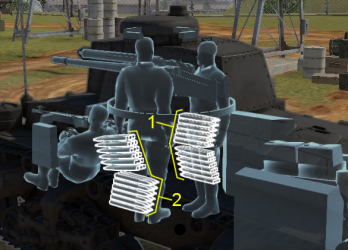
| Full ammo |
1st rack empty |
2nd rack empty |
Visual discrepancy |
|---|---|---|---|
| 72 | 37 (+35) | 1 (+71) | No |
Notes:
- Racks disappear after you've fired all shells in the rack.
- To go into battle with the right flank empty of ammo, pack 37 (+35) shells (rack 1 emptied).
Machine guns
| 7.92 mm MG37(t) | ||||
|---|---|---|---|---|
| Mount | Capacity (Belt) | Fire rate | Vertical | Horizontal |
| Coaxial | 1,800 (200) | 768 | N/A | N/A |
The small calibre of the MG37(t) machine gun makes it largely ineffective against all armoured vehicles but the ones with an open compartment. It still can be used to ping targets as a rangefinding help or to mow down minor obstacles blocking your line of sight.
Usage in battles
The tank is average in most aspects, aside from frontal immunity to .50 cals. Since your common enemies (eg. BT-5s) are faster than you, it is advisable to use this tank as a mid-range support vehicle. At the start of the match, avoid getting surrounded by enemies by not rushing to the frontline straight away, because its hull and turret traverse are all quite bad, making it vulnerable to surprise flanks. Find hilly terrain and utilise your 10 degrees gun depression to poke out, get a shot, then get back into cover before the enemies notice you.
At the middle stages of the match, only go to the frontline when you really need to, because, again, the traverse speed is low and the manoeuvrability isn't great. However the player can now use the tank's small profile to ambush enemies near a friendly point. With their decent penetration up close and the 22 g TNT, the APC rounds can quickly finish off anyone trying to de-cap the point.
Note that the default shell Pzgr. 34(t) has no tracer component, and the player can use this to their advantage. If the player misses the shot, the enemy will not see the trajectory of the shell thus will take longer to locate the shooter.
Enemies worth noting:
- BT-5, BT-7, M2, M3 Stuarts: If those tanks survive the first few minutes of point-capping, then they can silently appear pretty much anywhere on the map, including your side. To avoid being flanked / circled, do not put yourself at the frontline, as previously suggested. If you see / hear one of them sneaking up around you, turn your hull and turret together to double the traverse speed so it's quicker to get the guns on them.
- B1 bis: If it is not possible to avoid fighting this tank, then the best solution is to try and flank it. Hitting the side armour and knocking out its crew is the best way. In a face to face combat, load the APCR and aim for the near-vertical driver's compartment. The B1's driver and commander (also the gunner for the turret) are lined up so a penetration is likely to kill both of them, disabling its mobility and turret for 10 seconds or so. Also don't forget to avoid the hull-mounted 75 mm gun.
Pros and cons
Pros:
- Gun depression of -10° is great for combating across any terrain
- Stock and unlockable ammo with explosive filler have decent penetration and good post-penetration damage
- Mobility and acceleration are decent for the tier
- Frontally immune to 12.7 mm machine guns, useful against foes like M13 MGMC
- Reverse speed of -34 km/h is excellent at pulling the tank out of danger
- Has a shoulder stabiliser, useful for close-quarters combat and shoot-n-scoot
Cons:
- Many other tanks are faster than it, like BT-5, A13, M3
- Gun is inadequate against higher tier tanks like T-70, T-28
- Poor survivability and armour against anything stronger than machine guns
- Low agility: sluggish hull traverse and slow turret rotation
History
The Czechoslovakian main battle tank prior to German occupation, 398 were built between 1936 and 1939. They called it the Light Tank vz (model) 35. Another 126 were exported to Romania in 1936, where they were called the R-2. The Germans seized 244 of the 35(t) models when they invaded in 1939, with another 52 kept by Slovakia. The 6th Panzer Brigade used the 35(t) in the invasion of Poland. The 6th Panzer Division used it used it most notably in the Battle of France and in the invasion of Russia. It was retired from German service in 1942 but remained in service until the end of the war in countries like Romania.
| Archive of the in-game description | |
|---|---|
|
The Škoda LT vz.35 light tank was developed between 1935 and 1936. This tank was put into service in 1936, and by 1937 it had become the primary tank of the Czechoslovakian army. Between 1935 and 1940, 424 LT vz.35 tanks were produced. 218 tanks of this model were accepted into service in Wehrmacht and used until 1942. The tank was inferior to the Pz.38(t) in many ways, and its crews were not sorry to see it go. The tank was equipped with a pneumatic servomotor that made it easier to control the transmission and brakes. However, in winter condition on the Eastern Front it would freeze, and the tank would have to be warmed up. While in Wehrmacht service the tank's crew was also increased to four from the original three. The crew included a commander, a gunner, and a loader, who combined the duties of a radio operator and a mechanic/driver. The tank's power train was redesigned and made highly reliable. For example, the tracks could go for 8,000 km (almost 5,000 miles) before wearing out. These tanks were used in combat operations in Poland, France, and the USSR. But while the Pz. 35(t) was effective in Poland and France, in the USSR it was, more often than not, helpless. | |
Media
- Images
A Pz.35(t) in Eastern Europe
- Skins
- Videos
See also
- Other vehicles of similar configuration and role
- Pz.38(t) A / Pz.38(t) F - similar Czech-designed light tank, the successor to the Pz.35(t) in the German tech tree.
- T-26 (Family)
- A13 Mk I
- I-Go Ko
- M13/40 (Family)
External links
- [Development] Pz-35t & T-26-4
- [Wikipedia] Panzer 35(t)
- [Tanks Encyclopedia] Panzerkampfwagen 35(t)
- [Military Factory] LT vz. 35 / PzKpfW 35(t)
| Germany light tanks | |
|---|---|
| Pz.II | Pz.II C · Pz.II C (DAK) · Pz.II C TD · Pz.II F · Pz.Sfl.Ic |
| Sd.Kfz.234 | Sd.Kfz.234/1 · Sd.Kfz.234/2 · Sd.Kfz.234/2 TD |
| Marder | Marder A1- · Marder 1A3 · Begleitpanzer 57 · DF105 |
| SPz PUMA | PUMA · PUMA VJTF |
| Wheeled | Sd.Kfz.221 (s.Pz.B.41) · Class 3 (P) · Radkampfwagen 90 · Boxer MGS |
| Other | Ru 251 · SPz 12-3 LGS |
| Argentina | TAM · TAM 2C · TAM 2IP · JaPz.K A2 |
| Czechoslovakia | Pz.35(t) · Pz.38(t) A · Pz.38(t) F · Pz.38(t) n.A. · Sd.Kfz. 140/1 |
| France | Pz.Sp.Wg.P204(f) KwK |
| Lithuania | Vilkas |
| USA | leKPz M41 |
| USSR | SPz BMP-1 |


